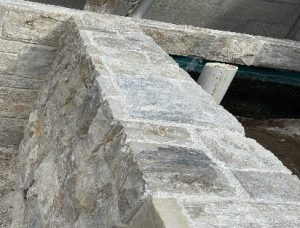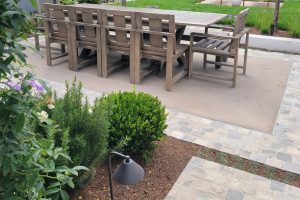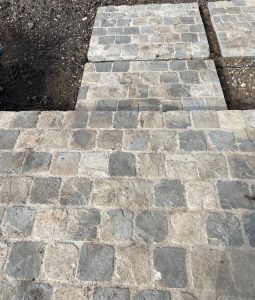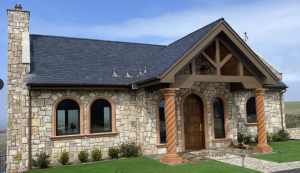Thin Stone Veneer is one of the most sought-after materials for exterior design due to its timeless appeal, durability, and versatility. Its rugged yet refined appearance adds character and value to homes and commercial buildings alike. This article by Lompoc Stone explains how thin stone veneer can transform any building by enhancing its architectural design while providing long-lasting protection from the elements.
Understanding Thin Stone Veneer
Flagstone siding goes beyond mere exterior cladding; it is a design choice that merges beauty with functionality. The material’s natural tones, textures, and durability make it a favorite among architects, designers, and homeowners.
What Is Thin Stone Veneer?
It is made from sedimentary stones like sandstone, limestone, and slate, which are quarried and cut into thin slabs. These slabs are installed on a building’s exterior to create a natural stone façade. The stones come in various shapes, sizes, and finishes, allowing for complete design customization.
Each piece is unique due to its natural formation process, featuring intricate patterns, veins, and textures that enhance a building’s visual appeal. Flagstone can be left in its irregular form for a rustic look or cut into precise shapes for a modern, streamlined appearance. The result is an elegant and long-lasting exterior that withstands both time and weather.
Why Choose Thin Stone Veneer?
Thin Stone Veneer stands out because of its combination of beauty, durability, and minimal maintenance requirements. Its natural aesthetic adds sophistication to a building’s exterior, boosting curb appeal and resale value. Beyond its appearance, flagstone’s strength makes it resistant to cracking, chipping, and fading, even in extreme weather conditions.
In addition to being weather-resistant, flagstone is an eco-friendly material due to its natural sourcing process. It requires no chemical treatments, and its longevity reduces the need for frequent replacements, making it a sustainable construction material. Furthermore, its insulating properties help keep homes warmer in winter and cooler in summer, enhancing energy efficiency and reducing utility costs.
Design Options for Thin Stone Veneer
The design versatility complements a wide range of architectural styles, from rustic cabins to modern luxury homes.
Choosing the right design option ensures a unique, personalized look tailored to your project’s style and setting.
Stacked Stone Design
The stacked stone design is a classic choice for a rugged, textured appearance. In this design, stones are laid horizontally in a tight, interlocking pattern with minimal gaps. The result is a layered, three-dimensional surface that creates depth and visual interest.
Stacked stone siding is often used for entire building façades but works equally well for accent walls, chimneys, and outdoor fireplaces. Its versatility extends to both interior and exterior applications, allowing you to create a consistent design theme throughout your property. Popular in both rustic and modern homes, stacked stone siding pairs well with wood, glass, and metal finishes, making it suitable for various architectural styles.
Mosaic Flagstone Design
For a more artistic and custom appearance, consider a mosaic flagstone design. This approach involves using irregularly shaped stones arranged like a puzzle, creating an organic and visually dynamic surface. The stones are often fitted together without a repetitive pattern, ensuring a completely unique installation. Thin Stone Veneer in a mosaic design works best for feature walls, garden enclosures, and decorative accents around windows or doors. Its organic layout brings an earthy, handcrafted feel to any structure, making it ideal for homes designed with a natural or rustic theme. This design style requires skilled craftsmanship due to the complexity of fitting irregular stones together, but the final result is well worth the investment.
Installation Process for Thin Stone Veneer
Proper installation is essential for ensuring the longevity and beauty of this stone. While professional installation is recommended for large-scale projects, understanding the basic steps involved helps you appreciate the craftsmanship behind a quality stone façade.
Surface Preparation
The first step in installing thin stone veneer is preparing the building’s surface. The wall must be clean, level, and structurally sound. Any cracks, loose materials, or water damage should be repaired before proceeding. If the wall is unsuitable for direct stone application, contractors typically install a metal lath or cement backer board to create a secure foundation.
This step is critical because a stable surface prevents the stones from shifting, cracking, or falling over time. The surface must also be moisture-proof to prevent water infiltration, which could cause damage to both the stone and the building’s structure. Proper waterproofing membranes and drainage systems should be installed in areas exposed to heavy rainfall.
Stone Application
Once the surface is prepared, the stone application process begins. Using a high-strength mortar or adhesive, installers start from the bottom of the wall and work their way up. This technique ensures that the stones are supported by the weight of those below, reducing the risk of slippage.
Each stone is carefully pressed into the mortar, and any excess is wiped away for a clean finish. The stones are either arranged tightly for a seamless look or spaced slightly apart for a more traditional appearance with visible grout lines. After the stones are set, grout is applied to the joints, and the surface is cleaned to remove any remaining mortar residue. Once cured, the wall is sealed to enhance its color and protect it from moisture and stains.
Maintenance Tips for Thin Stone Veneer
Routine maintenance is essential for preserving the natural beauty and structural integrity. Following a regular care routine can keep your stone façade looking its best for decades.
Cleaning and Sealing
To maintain its appearance, thin stone veneer should be cleaned periodically using water and a mild detergent. A soft-bristled brush helps remove dirt, dust, and algae without scratching the stone’s surface. Avoid using abrasive cleaners or pressure washers, as they can damage the stone or strip away its protective sealer.
Applying a high-quality stone sealer every 3-5 years helps prevent moisture absorption, stains, and UV damage. Sealers enhance the stone’s natural color and create a barrier against water, reducing the risk of weather-related wear. For buildings in wet or humid climates, more frequent sealing may be necessary.
Inspecting for Damage
Regular inspections help identify potential issues early. Look for signs of mortar deterioration, loose stones, or cracks caused by shifting foundations. Addressing minor problems quickly prevents costly repairs and extends the siding’s lifespan. Professional inspections every few years are recommended for large or multi-story installations.
Environmental and Energy Efficiency Benefits
In addition to its aesthetic and structural advantages, this siding offers significant environmental and energy efficiency benefits. Its natural composition, sustainability, and insulating properties make it an eco-friendly choice for modern construction projects.
Energy Efficiency
One of the most valuable features of thin stone veneer is its ability to regulate indoor temperatures through thermal mass. Flagstone absorbs heat during the day and slowly releases it at night, helping to maintain a stable indoor environment. This natural insulation reduces reliance on heating and cooling systems, lowering energy consumption and utility costs.
In colder climates, flagstone helps retain warmth, minimizing heat loss through exterior walls. In warmer climates, its reflective properties keep interior spaces cooler by deflecting the sun’s rays. When paired with other energy-efficient building materials, flagstone siding contributes to an environmentally sustainable home design.
Eco-Friendly Material
Flagstone is one of the most sustainable building materials available. Its natural formation process requires minimal processing, reducing the carbon footprint associated with its production. Because flagstone is quarried directly from the earth, it doesn’t require chemical treatments or synthetic coatings. Additionally, flagstone’s durability means it rarely needs to be replaced, reducing construction waste over time. Its ability to be reused and repurposed makes it an environmentally responsible choice for eco-conscious homeowners and builders. Selecting thin stone veneer for your project supports sustainable building practices while ensuring long-lasting beauty and performance.
FAQs
Is Thin Stone Veneer suitable for all climates?
Yes, thin stone veneer is highly durable and performs well in various climates, including areas with extreme heat, cold, or heavy rainfall. Its resistance to weathering makes it a popular choice worldwide.
How long does Thin Stone Veneer last?
With proper installation and regular maintenance, thin stone veneer can last for several decades, often outliving other exterior materials like vinyl or wood siding.
Does Thin Stone Veneer need to be sealed?
Yes, sealing thin stone veneer is recommended every 3-5 years to protect it from moisture, stains, and UV damage. Sealing enhances the stone’s natural color while extending its lifespan.
Can Thin Stone Veneer be installed on all types of buildings?
Flagstone siding can be installed on most residential and commercial buildings, provided the surface is properly prepared. It works well on concrete, brick, and wood-framed structures when installed with the correct adhesive and support system.
Is Thin Stone Veneer expensive to maintain?
No, thin stone veneer requires minimal maintenance. Routine cleaning with water and mild detergent, along with periodic sealing, is usually sufficient to keep it looking beautiful for years.
Conclusion
Thin Stone Veneer is the ultimate combination of natural beauty, durability, and timeless design. Its rugged textures, rich colors, and versatile styles make it suitable for a variety of architectural projects, from modern homes to rustic retreats. For premium flagstone products, trust Lompoc Stone, a leading supplier of natural stone materials known for exceptional quality and expert service.Contact Lompoc Stone today to explore an extensive selection of thin stone veneer options that can transform your home’s exterior into a work of art.






